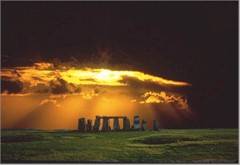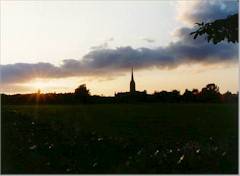


Stonehenge is a Bronze Age monument just west of Amesbury in Wiltshire. A world heritage site, it is unfortunately not well managed by the government. Perhaps the best view is obtained from the road. You can approach the site on foot via a tunnel under the road, but cannot enter the stone circle itself. A little known fact is that you can pay a modest fee and rent the place for yourself for an hour after or before opening times. This is undoubtedly the best way to see Stonehenge. You have to make the arrangement and pay in advance, but it is well worth it. To get the details enquire directly to the site.
 |
 |
 |
Stonehrnge is so old that nobody really knows why it was built (probably as a astronomical calculator), how it was built (the vast stones came from Wales over 200 miles way) or exactly how it evolved. Note the crop circles on the nearby field - these are appaently caused by spacecraft from outer space being attracted by the power of the area :-)
 |
|
 |
The largest of the central stones is 21 feet high, and they ate arranged in concentric rings. Then 256 feet away from the ring is the heelstone, over which the sun rises on mid-summer's day. Also in the area are other pre-historic sites like Woodhenge (just north of Amesbury) and the Avebury Ring. Certainly the Salisbury Plain was the centre of something big over 2000 years B.C.
 |
 |
 |
Also in the area is Longleat House, one of Britain's great Elizabethan houses, commenced in 1568 and incorporating gardens by Capability Brown. The city of Salisbury with its cathedral is also close by.
 |
|
 |
Return to South East England South East England page
You do not appreciate the size of it from most photos as people are not allowed into the ring. On the photo below the yellow blob, silhouetted centre right between two stones is a person. Stonehenge is worth a visit, but remains an example of how things could be done better!
